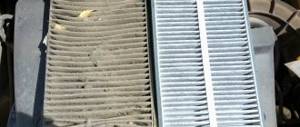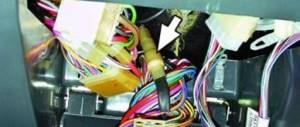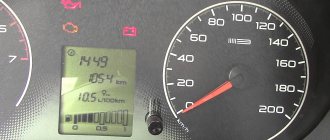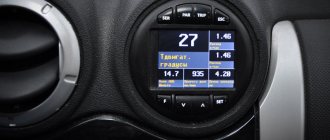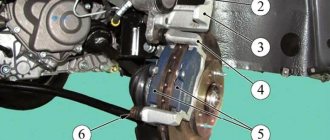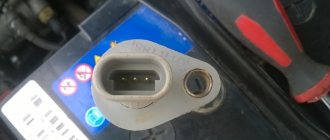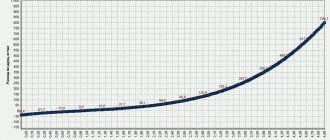A car engine is a complex system consisting of many components and assemblies, so it is not surprising that from time to time one of them fails - either on its own or due to external factors. One of the most common “symptoms” of a malfunction of any mechanism in the engine is a situation when the car does not want to start. Most often this happens in winter, for example, when there is frost, wind, snowfall, or simply in cold weather.
Is this a familiar situation? You get into your car in the morning, turn the key in the ignition, and what a surprise - the starter does not turn! You try to start the car again and again and again - but your faithful Lada Granta only “sneezes” a few times and stalls. As a result, you are late for work, cancel meetings, cannot complete other tasks planned for the day, and begin to get more and more nervous. In fact, you need to worry: there is a chance that, having the necessary knowledge and skills, you can find the reason why the Lada Granta stalled and try to eliminate possible malfunctions. In most cases, you will most likely have to use the services of a car service, but why not try your luck yourself first?
So, the Lada Granta will not start. How to proceed in this case? First of all, you need to understand that “won’t start” is a loose concept.
Reasons why it is difficult to start when cold
It is important to distinguish between situations in which problems arise: the car is hot and has difficulty starting, it has difficulty starting after being idle, when it cools down, (especially in the morning) if it refuses to start in cold weather. They all have their own nuances and reasons that should be considered separately .
We will understand in general terms what reasons lead specifically to poor starting of a cold engine. Usually one or two rotations of the starter armature shaft are enough to start a car in good condition. If this cannot be done, you need to look for why.
Main reasons:
| Causes | Carburetor | Injector | Diesel |
| Low fuel quality | |||
| Poor fuel pump performance | |||
| Clogged fuel filter | |||
| Low fuel pressure | |||
| Low fuel level in carburetor | |||
| The pressure regulator in the fuel line is faulty | |||
| Air leak | |||
| Poor condition of spark plugs | |||
| Malfunction of high-voltage wires or ignition coils | |||
| Dirty throttle valve | |||
| Idle air valve contaminated | |||
| Malfunction of air sensor indicators | |||
| Engine temperature sensor glitch | |||
| Valve clearances are knocked down or incorrectly set | |||
| Incorrect oil viscosity (too thick) | |||
| Low battery charge |
In addition to these cases, there may be others, less common, but equally significant. We will also mention them below.
Troubleshooting Tips
On gasoline engines, an indicator that it is difficult to start and stalls when cold can be a spark plug . We unscrew it and look: if it’s flooded, it overflows, we look further down the points; dry - lean mixture, we also sort out the options. This method of analysis will allow you to start finding out with simpler ones and gradually approach more complex reasons for poor engine starting when cold, rather than looking for them in the fuel pump, disassembling the injector, getting into the timing mechanism, opening the cylinder block, etc.
But for a diesel engine, the first on the list of faults will be weak compression . So owners of diesel cars should pay special attention to it. In second place is the quality of the fuel or its inconsistency with the season, and in third place are glow plugs .
Tips for starting the engine in cold weather
- Keep the tank full - this will prevent condensation from forming and water will not get into the fuel.
- Turning on the high beams for a couple of seconds before starting will restore some of the battery capacity on frosty days.
- After turning the key in the ignition switch (on an injection car), wait a few seconds until normal pressure is created in the fuel system, and only then start the engine.
- Pump up gasoline manually (on a carburetor car), but you must not overdo it, otherwise the spark plugs will flood.
- Cars run on gas, under no circumstances should you start them cold, switch to gasoline first!
Reasons why a diesel engine does not want to start
A diesel engine is distinguished by the absence of spark plugs and the principle of compression ignition. Often the car does not start because the diesel engine is very demanding on the quality of fuel, especially when driving in winter.
That’s why you can protect yourself by using special depressant additives, or in common parlance – anti-gels. Such additives prevent diesel fuel from freezing during cold periods. The range of such additives is wide; it is recommended to choose products from well-known manufacturers that have proven their effectiveness and safety. One of the leaders in tests and consumer reviews is the product of the famous German brand, LIQUI MOLY Diesel Fliess-Fit antigel. The product is distinguished by a high degree of fuel modification and absolute safety for the fuel equipment of a diesel engine.
Low diesel engine compression
The second significant problem is low compression in a diesel engine. Low compression can be caused by:
- wear of the cylinder-piston group;
- coked rings.
If only major repairs will help with the first problem, then the second problem can be solved by high-quality prevention. During operation, carbon deposits, sludge and varnish contaminants form inside the engine. The process is inevitable; over time, a situation arises when carbon deposits prevent the compression rings from working correctly. Compression drops, the pressure becomes insufficient to ignite the fuel mixture.
Prevention of such problems involves the use of special flushes of the oil system to remove carbon deposits. One of the best tools for this is Oilsystem Spulung High Performance Diesel. The flushing composition is designed specifically for use in a diesel engine, which allows you to achieve maximum effect from the application.
3 SIMPLE STEPS TO AVOID MOST PROBLEMS WITH VEHICLE STARTING
One of the main problems in Russian conditions that causes poor vehicle starting is the quality of Russian fuel and the consequences of its use: deposits in the fuel system, clogging of nozzles, injectors, etc.
To prevent such vehicle problems, we recommend:
- Check the battery before the winter season, replacing it every 3 years.
- Use fuel cleaning and lubricating additives.
- Use fuel additives that remove moisture from the tank. One of the best additives is the Anti-Ice fuel additive Fuel Protect from LIQUI MOLY.
- Clean the injectors. We also recommend using fuel additives from LIQUI MOLY.
- When carrying out maintenance, it is imperative to inspect the condition of the vehicle’s electrical circuits, clean them in a timely manner and use special protective equipment. For cleaning: Kontaktreiniger safe contact cleaner. For protection: Electronic-Spray for electrical wiring.
- For diesel engines, we recommend adding anti-gel at every refueling in winter, especially in warm (!) weather. This is due to the fact that some gas stations in warm winter weather can sell diesel fuel without a sufficient amount of expensive “winter” additives, and then cold weather comes and the engine does not start.
The most important rule for the proper operation of any car is proper and high-quality prevention. As in medicine, it is easier to prevent a disease than to treat it.
In the article, we examined only a small part of the reasons that can cause malfunctions of both the engine separately and the vehicle as a whole. But even this short article, we hope, will help avoid many problems that arise during operation.
The injector does not start well when cold
The first thing you should pay attention to when an injection car is performing poorly is the sensors. Failure of some of them leads to difficulty starting the engine, since incorrect signals are sent to the ECU. It is usually difficult to start when cold due to :
- coolant temperature sensor, DTOZh informs the control unit about the state of the coolant, these indicators affect engine starting (unlike a carburetor car), adjusting the composition of the working mixture;
- throttle sensor;
- fuel consumption sensor;
- Mass air flow sensor (or MAP, intake manifold pressure sensor).
Often there is a problem with cold starting due to the fault of the fuel pressure regulator . Well, of course, whether it’s an injector or a carburetor, when a cold car doesn’t start well, if it stalls, the speed jumps, but after warming up everything is fine, then it’s imperative to check the condition of the spark plugs, and use a multimeter to check the coils and explosive wires.
Leaking injectors cause a lot of trouble when it’s hot outside, the car will have difficulty starting on a hot engine, and in the cold season a dripping injector will cause difficulty starting in the morning . To test this theory, it is enough to simply release the pressure from the vehicle in the evening so that there is nothing to drip, and look at the result in the morning.
We cannot exclude such a banal problem as air leaks in the power system - it complicates starting a cold engine. Also pay attention to the fuel poured into the tank, since its quality greatly affects engine starting.
On cars such as the Audi 80 (with a mechanical injector), we first check the starting injector.
Why isn't the car .
The main reasons why a car does not start well when cold are:
Weak dead battery
This factor of poor engine starting is widespread! Frost leads to accelerated discharge of batteries.
- The vehicle can be started by replacing the battery with a charged one, or charging the existing one;
- if the car allows it. In this case, be sure to take into account the sequence of actions specified in the operating instructions.
Advice! If you doubt whether the vehicle will start in cold weather due to a dead battery, then you should understand that the battery will have the strongest charge only when you first try to start the engine. From the moment the car is opened with the key fob, processes that consume electricity are started in the system, so it is important to act quickly!
The greatest likelihood of starting a vehicle with a dead battery is:
- Standing next to the car, open it and immediately sit in the driver’s seat, turning on the ignition.
- Wait 2-4 seconds for all vehicle systems to activate.
- Turn the ignition key further, activating the starter and starting the engine.
Low spark level
The second, common case is a low level of sparking.
This may happen for the following reasons:
- when spark plugs fail;
- if the electrical connections of the ignition system are broken;
- when the ignition coils fail
In this case, it is necessary to identify the causes and eliminate the source of the malfunction that prevents the vehicle from starting when the engine is cold.
It is enough to replace the spark plugs and check all connections of the ignition system.
The carburetor does not start well when cold
Most of the reasons that an engine with a carburetor does not start well, or does not start at all, is due to malfunctions of such elements of the ignition system as: spark plugs, explosive wires, coil or battery. Therefore , the first thing to do is to unscrew the spark plugs - if they are wet, then the electrician is to blame.
The main reasons why the carburetor does not start when cold:
- Ignition coil.
- Switch.
- Distributor (lid or slider).
- Incorrectly adjusted carburetor.
- The starter diaphragm or the fuel pump diaphragm is damaged.
Of course, if you pump up gasoline before starting and pull out the choke more, it will start better, but all these tips are relevant when the carburetor is correctly configured and there are no problems with the switch or spark plugs.
Advice from an experienced VAZ 2110 car owner: “When the engine does not start on a cold engine, you need to smoothly press the gas pedal all the way, turn the starter and release the pedal back, as soon as it grabs, keep the gas in the same position until it warms up.”
Let's look at some typical cases when it won't start when cold:
- when the starter turns but does not engage, it means either there is no ignition to the spark plugs, or gasoline is not flowing either;
- if it seizes, but does not start, most likely the ignition or, again, gasoline is faulty;
- If the starter does not turn at all, then the battery is probably dead or something related to it.
Why is it difficult to start a cold carburetor?
If everything is normal with oil, spark plugs and wires, then the ignition may be late or the starting valve in the carburetor is not adjusted. However, there may also be a torn membrane in the cold start system , and the valve adjustment also says a lot.
Difficult to start on cold diesel
As you know, starting a diesel engine occurs due to temperature and compression, therefore, if there are no problems with the battery and starter, there may be 3 main ways to find the reason why a diesel engine does not start well in the morning when it’s cold:
- Insufficient compression.
- No glow plug.
- is missing or interrupted .
One of the reasons that a diesel engine does not start when cold in particular, and poor diesel starting in general, is poor compression . If it doesn’t start in the morning, but seizes from the pushrod, and then there is blue smoke for a certain time, then this is 90% low compression.
Checking engine compression
Checking engine compression with a compression gauge and without instruments with your own hands. How to measure compression in gasoline and diesel engines. Compression diagnostics. More details
An equally common case is when the owner of a car with a diesel engine cannot start a cold engine, but a hot one starts without problems - if there is no glow on the spark plugs . Glow plugs heat diesel fuel until the diesel engine reaches operating temperature completely.
There may be three options why the candles do not work
- the spark plugs themselves are faulty;
- It's the spark plug relay. Its operation is regulated by the coolant temperature sensor. During normal operation, the relay makes quiet clicks when the key is turned in the ignition before starting, and if you cannot hear them, then you should find it in the block and check it;
- oxidation of the glow plug connector. There is no point in explaining how oxides affect contact.
3 options for checking glow plugs
To check diesel spark plugs, you can choose several methods :
- measure their resistance (on an unscrewed spark plug) or an open circuit in the heating circuit with a multimeter (checked in the beeper mode, both screwed into the engine and after unscrewing it);
- check the speed and degree of heating on the battery by connecting to ground and the central electrode with wires;
- Without unscrewing it from the engine, connect the central wire to the positive terminal of the battery through a 12 volt light bulb.
If the spark plugs are working and they are properly supplied with power when the ignition is turned on, then in some cases it is necessary to check the valve clearances. Over time, they become confused and do not close completely when the internal combustion engine is cold, but if you start it and warm it up, they close up and the engine starts normally when it is hot.
Faulty diesel injectors , as a result of natural wear or contamination (sulfur and other impurities), are an equally important aspect. In some cases, the injectors throw a lot of fuel into the return line (you need to do a test) or the fuel filter is dirty.
Interruptions in the fuel supply make it much more difficult to start the engine. So, if the diesel engine stops starting in the morning, regardless of the temperature outside, the diesel fuel is leaving (the return valve does not hold), or it is sucking air, other options are less likely! Air entering the fuel system can cause the diesel engine to have difficulty starting and stalling.
Fuel is out of season or contains foreign impurities . When it is cold outside and the diesel engine does not start or immediately stalls after starting, then the problem may be in the fuel. DT requires a seasonal transition to “summer”, “winter” and even “arctic” (for especially cold regions) diesel fuel. A diesel engine does not start in winter because unprepared summer diesel fuel in the cold turns into a waxed gel in the fuel tank and fuel lines, and also clogs the fuel filter.
In this case, starting the diesel engine helps by heating the fuel system and replacing the fuel filter. Frozen water on the filter element presents no less difficulties. To prevent water accumulation in the fuel system, you can pour a little alcohol or a special diesel fuel additive into the tank, called a dehydrator.
Tips for diesel car owners:
- If, after pouring boiling water on top of the fuel filter, the car starts and works normally, the diesel fuel is summer.
- If there is low pressure in the fuel rail, the injectors are probably leaking and not closing (the operation is checked on a special stand).
- If the check shows that the injectors are pouring into the return line, then the needle in the sprayer does not open (they need to be changed).
10 reasons why diesel engines have trouble starting when cold
If a diesel engine has trouble starting when cold, the reasons can be collected in a single list of ten points:
- Starter or battery faulty.
- Insufficient compression.
- Faulty injector/injectors.
- Incorrectly set injection timing, desynchronization with fuel injection pump operation (timing belt jumps by one tooth).
- Air in fuel.
- The valve clearance is incorrectly set.
- Malfunction of the preheating system.
- Additional resistance in the fuel supply system.
- Additional resistance in the exhaust system.
- Internal breakdown of the injection pump.
I hope that all of the above will help you, and if it does not solve the problem of starting a cold engine, it will at least point you on the right path to eliminating it on your own or with the help of a specialist.
Difficulties starting the engine “cold” arise in different situations. Firstly, leaving the car in the cold for a long time. This could be one night or several weekends. Secondly, the cooling of the internal combustion engine after it has warmed up to operating temperatures, stopped and attempted to restart after some time.
Difficulty starting gasoline and diesel engines has similar causes, but manifests itself in different ways. This applies to engines with carburetor and injection fuel supply systems that have design differences.
In this article we will talk about common problems that lead to additional difficulties when trying to start the engine “cold”, we will give recommendations for owners of cars with power plants running on gasoline and heavy fuel.
Why does a warm engine stall?
Some motorists are faced with a situation where an already running and warmed-up engine suddenly stalls. Moreover, this happens after the sensor has recorded a set of normal operating temperatures. There may be several reasons for this. Next, we will consider them in more detail, and also indicate what needs to be done in this or that case.
- Poor quality fuel . This situation is typical, for example, if you are driving away from a gas station, and after a short period of time the engine begins to “cough”, the car jerks and stalls. The solution here is obvious - drain the low-quality fuel, bleed the fuel system and replace the fuel filter. It is also advisable to replace the spark plugs, but if they are new, you can get by by blowing them out. Naturally, you shouldn’t go to such a gas station in the future, but if you have saved your receipt, you can go there and make a claim about the quality of the fuel.
- Fuel filter . If the engine stalls, you should also check the condition of the fuel filter. And if according to the regulations it is already necessary to replace it, then this must be done, regardless of whether it is clogged or not yet.
- Air filter . The situation is similar here. The engine may “choke” on the rich mixture and stall shortly after starting. Check its condition and replace if necessary. By the way, this way you can also reduce fuel consumption.
- Gasoline pump . If it does not operate at full capacity, the engine will not receive enough fuel and, accordingly, will stall after a while.
- Generator . If it completely or partially fails, it stops charging the battery. The driver may not immediately notice this fact, start the engine and drive off. However, it will only drive until the battery is completely discharged. Unfortunately, it will no longer be possible to start the engine on it again. In some cases, you can try to tighten the alternator belt. If this procedure does not help, you need to call a tow truck or call your friends to have your car dragged to a garage or service station.
Preparatory activities
To simplify your task in finding the cause of the malfunction, check the following:
1. Presence of exhaust gases.
There should be light smoke coming from the exhaust system when the starter rotates. It indicates that fuel is entering the cylinders.
2. Battery charge level.
A completely discharged battery is one of the most common reasons why a car engine will not start. Therefore, we check the battery charge level.
3. Serviceability of the starter (the engine should spin without failure).
If the starter does not spin the crankshaft, then a dead battery is to blame. If not, then the problem lies elsewhere. For example, the contact between the ground and the starter housing has oxidized.
The main causes of problems during cold engine starts
Low quality fuel
The likelihood of refueling a car with low-quality fuel at certified gas stations in large cities is very low. It is much easier to encounter counterfeit products at little-known gas stations on the highways or when purchasing fuel second-hand. Such fuel does not pass quality control and contains a large amount of impurities that contaminate filters and fuel pipe channels. As a result, the pressure in the system decreases and the car does not start.
The use of low octane gasoline is determined by the following criteria:
- too noisy operation of the internal combustion engine;
- reducing the dynamic characteristics of the car;
- detonation.
In diesel engines, a problem may arise due to the fuel selected “out of season.” An owner who uses diesel fuel for the summer during the winter period of operation of the vehicle will encounter difficulties. The main reason is the discrepancy between the physical and chemical properties of the fuel and the operating conditions.
Causes of poor engine starting "hot"
For a novice car enthusiast, a difficult start when hot looks like something supernatural. Why is the engine difficult to start? Just half an hour ago I started the car with half a click, a hot engine is guaranteed, but now the car won’t start! Miracles, and that's all. No magic - banal mechanics and physics. If the car does not start when hot, the reason may be a malfunction of some sensor. Incorrect operation of one sensor can cause engine failure as a whole.
Possible faults
No matter how trivial it may sound, if the injector does not start, it means something has gone wrong. The success and speed of repair depends on how quickly and efficiently the problematic link in the car’s design can be identified. To better understand the essence of repair activities, it would be a good idea to pay attention to potential breakdowns. The basic list of the latter is as follows:
- Malfunctions of the injector itself. In the event of a breakdown of this kind, as a rule, the car does not start either cold or hot. On top of that, the injector indicator on the dashboard or on-board computer constantly lights up, signaling its malfunction. It is much less common for the engine to work when the indicator is on, but in this case the car starts poorly and is extremely unstable. It is worth noting that the injectors in the injector most often become clogged or the ECU burns out, so it is advisable to check these components first;
- Ignition system failures. Here the list of possible faults is quite large. Often the candles that suffer are simply flooded. In the event of such a breakdown, the car starts and immediately stalls, but in the long term it stops even “grasping.” Other components of the ignition system (coil, module, distributor, crankshaft sensor, etc.) are noticeably less likely to suffer;
- Incorrect operation of the fuel system. In this aspect, injection engines most often suffer on three fronts:
- Fuel filters are clogged (the car “picks up”, but does not start; if the engine starts, it is extremely unstable);
- The fuel pump is faulty (its characteristic operating sound is absent when you turn the ignition key, the injector itself simply does not start both cold and hot, the starter turns).
- There is insufficient pressure in the fuel system (the engine starts up reluctantly both cold and hot, but if it starts working, it functions unstable);
- Engine problems. Perhaps the widest range of possible malfunctions. Often the reason lies in weak compression or incorrectly adjusted valves. In any case, with a “motor” starting problem, high-quality engine diagnostics are required, otherwise it will be very difficult to determine the cause of the malfunction.
In addition to the breakdowns described above that can break the operation of the injector, the problem may lie in more trivial things. An example of this is a weak battery charge or lack of fuel in the tank. Considering just such incidents, before repairing a car, it is extremely important to exclude the possibility of their occurrence, so as not to waste extra time and nerves.
Injection power unit
With a carburetor engine everything is very clear, but in the case of an injector, you will need to tinker a lot. First of all, it is recommended to check the cooling system temperature sensor. It is because of incorrect data that the electronic engine control unit can disrupt the fuel supply and create a lean mixture.
The next place to look for a problem is the injectors. It is defective fuel injection that can lead to the engine being difficult to start not only when the engine is hot, but also when it is cold. To check the elements, you need to dismantle them from the car and then check them on a special stand.
It is also worth paying attention to the fact that there may be a rupture of the fuel regulator membrane. As a result, gasoline enters the intake manifold, which leads to an enrichment of the combustible mixture. In turn, an over-enriched mixture is difficult to ignite, and in most cases does not burn at all.
But, for an injection engine, these are not all the reasons. The most common reasons were discussed earlier, and now it is worth considering less common causes. Let's start with the fact that the check valve of the fuel pump may fail, which will pump fuel back and after turning off the engine there will be no gasoline in the system until it is restarted.
Also, meters and sensors can affect the repeated hot start of the motor. Thus, failure of the following meters may make it difficult to start the engine when hot:
- Crankshaft position sensor. Incorrect measurement of the crankshaft position will lead to the fact that the data received by the electronic engine control unit is not reliable, and accordingly the normal supply of fuel to the combustion chambers will be disrupted.
- Mass air flow sensor. If this meter fails, air can enter in large quantities, which leads to an incorrect air-fuel mixture ratio. In turn, this causes poor engine starting.
- Idle speed sensor. This meter is involved in the start-up and initial operation of the engine, and therefore its failure complicates not only the start-up of the power unit, but also its idling operation.
- High voltage wires. On an injection engine, it is quite difficult to identify a malfunction in high-voltage wires, since they are indirectly related to many malfunctions. But checking the elements is quite simple. To carry out diagnostic operations, it is necessary to dismantle the elements from the vehicle and ring each element with a tester. The resistance should be about 5 ohms.
Another significant reason for the poor start of a fuel-injected car is the failure of the software of the electronic engine control unit. To determine the malfunction, you will have to connect directly to the on-board computer and conduct a full diagnostic. If any faults are found, they should be corrected.
Many motorists try to fix the problem themselves. This is not recommended, as it can only cause harm. As practice shows, it is worth contacting professionals who will quickly classify the fault and fix it.
The procedure for returning the car to “life”
Let's say you find yourself in circumstances where the injection engine starts poorly or refuses to do so at all. There is no need to hesitate in such a situation - it is advisable to immediately begin resuscitation procedures. If you don’t have time to figure out the exact reason why the car doesn’t start well, then you should quickly carry out the following algorithm of actions:
- First of all, we check the availability of gasoline and battery charge. Is there something missing? Fill it up and light it up. Let's try to start. If there is no result, proceed to the next step;
- Next, we quickly analyze under what circumstances the car malfunctions. If it takes a long time or is difficult to start when hot, we first check the spark plugs for overheating (light carbon deposits) and the functioning of the fuel system. Otherwise, when the car malfunctions both cold and hot, a more comprehensive approach is required. As a rule, the following procedures are sufficient: checking spark plugs, wiring the ignition system, assessing the operation of the injector and fuel system;
- Note that most motorists manage to solve the problem, so to speak, with little loss, that is, by implementing the actions described above. If you are not one of the lucky ones and your car still takes a long time, starts poorly or refuses to work at all, you will have to act globally. Here it is better to take the car to a service station or a convenient garage and check the compression, timing adjustment, clean the injector, assess the condition of the fuel system and ignition devices. If there are any malfunctions, they must, of course, be eliminated.
In general, there are no particular difficulties in repairing a non-starting injector. The main thing in the process of such work is to act competently, in accordance with the procedure and possible vehicle malfunctions described above.
Prevention of injector breakdowns
Why the injection engine does not start and how to eliminate possible problems is now known to all readers of our resource. However, it is better to avoid such breakdowns, so let’s pay attention to ordinary procedures that, if carried out systematically, will help minimize the risks of all malfunctions. The simplest but most effective prevention consists of the following measures:
- Firstly, refuel exclusively at proven gas stations and only with high-quality fuel. Remember that most fuel system and engine malfunctions are caused by dirty gasoline;
- Secondly, change all consumables on time and only with high-quality products. The most important thing is periodic replacement of all kinds of filters and engine oil;
- Thirdly, periodically check the main components of the machine for stability. The list of the latter, naturally, includes the injector, elements of the fuel system, ignition and engine;
- Fourthly, never neglect routine diagnostics of your car at a service station. Surprisingly, even a delay of a couple of hundred kilometers can cause serious damage, which previously could have been eliminated with very simple actions;
- And fifth, always operate your vehicle properly. That is, you do not need to overheat, overload or negatively impact your car in any other way.
Perhaps this is where the most important information on today’s issue has come to an end. We hope the material presented above was useful and provided answers to your questions. Good luck in operating and maintaining your car!
Diesel
For a diesel engine, the primary cause is the high pressure fuel pump. Often the cause of the malfunction is quite simple - failure of the oil seals and bushings. In this case, routine maintenance of the unit will help. On the other hand, the reason may be hidden in the breakdown of the plunger pair, which actually leads to a major overhaul of the element.
Another element that will affect starting the engine when hot is the temperature sensor of the control injector. Failure of this electronic element will cause a changed injection angle. To fix the problem, you need to replace the sensor.
As for injection engines and diesel power units, a malfunction of the engine control unit disrupts the operation of all systems. To fix the problem, you will have to connect to the motor and carry out repair and diagnostic operations.


